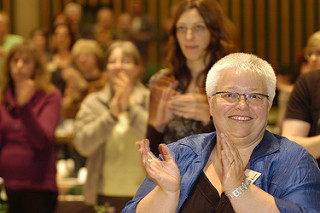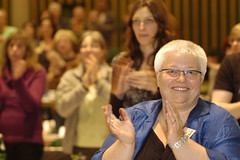A small meme developed on Twitter yesterday prompted by the following tweet by David Wedamen, “Just had a GREAT idea from @brandeislibn. Conferences should be built around TEACHING not PRESENTING. Wouldn’t that be something?” (Thanks to Michael Stephens for retweeting and bringing to my attention.)
Alice Yucht built on the idea with her tweet, “how about Conferences should be about LEARNING, not Show-n-Tell ?”, which got me thinking about how we approach conferences, and conference presentations, in the library profession. If the goal of the conference is that attendees will learn, what do conference presentations have to look like to achieve that goal?
I believe the goal of presenting should be to a create a change in the listener; a change of behavior, thinking and/or feeling. Any good teacher or trainer will tell you that to be effective in creating that change, you must begin with the learning objective(s) in mind, and work backwards from there to design the lesson or the talk.
CONFERENCE PRESENTING: THE CART BEFORE HORSE?
Wedamen’s tweet points out an interesting feature of many library conferences—they seem to be designed around topics that presenters wish to present on, more than they are designed around, or focused on, the learning that participants need. In too many conference presentations speakers design their talks as core dumps of data, or long, dry recountings of “how we did it good”, without giving enough attention to the key question, “As a result of hearing me speak, people will do/think/feel_________ “(fill in the blank).
The answer to that question is the main organizing principle, the guiding star, of any well-constructed talk. Leaving out all of the other variables that go into an effective presentation (emotion, humor, pacing, eye contact, vocal variety, body language, visuals, questions, room environment, acoustics, etc.) it is very difficult to have a successful presentation if what constitutes success is a mere afterthought (or worse, if success is constituted by the fact that the speaker got a chance to speak at a conference…)
PUT THAT HORSE BACK! TEN THINGS YOU CAN DO TO EFFECTIVELY PROMOTE LEARNING WITH YOUR TALK
- Ask, “What do I want them to do, think, and/or feel as a result of hearing this program?” Ask and answer this question before you write one word or create one slide. The answer to this question is your OBJECTIVE. Let the objective guide you continually as you construct your presentation, throwing aside anything that does not help achieve the goal of the talk.
- Share your objectives with the audience at some point during your presentation–preferably during the first few minutes. If the audience knows what you intend to achieve with the talk it will give them context that will help them make meaning and ground the learning. It will also help them evaluate whether you have effectively achieved your goal. Or not.
- Have a strong opening.The first two minutes of your talk gives you a great opportunity to grab and hold the audience’s attention, but it’s likely that you already have their attention during the first two minutes. It’s the next 58 that present the challenge! So what do I mean by a strong opening? I mean an opening that engages the audience, creates some positive expectation for the rest of the talk, and/or provides a framework for the learning that is about to take place. Olivia Mitchell, who blogs over at Speaking and Presenting, suggests three possible openings – Organized Opening, Story Opening, Dramatic Opening — and discusses when/why to use each.
- Use examples to illustrate your points. For example… Don’t just say, “Merchandising your collection is good.” Say, “When we created a ‘recently returned’ display at the front door and displayed them all covers out, 98% of them recirculated within the same day and our circulation stats increased 20%.” Examples support the learning by attesting to the truth of your message, and also help ground the learning by clarifying and fleshing out your meaning.
- Use simple, clear, engaging visuals to reinforce your points (or don’t use them at all.) Good visuals can help you focus the audience’s attention, help them make meaning, and promote future recall, by connecting intellectual ideas with visual representations. As for bullet points… I’m not one of those people that believes bullet points should never be used, but if you use them, do it sparingly, with a large readable font, and a supporting image (if room permits.)
- Tell stories. Our brains are actually wired to enjoy stories. And because stories have the power to simultaneously engage the listener both cognitively AND emotionally, they are highly effective in getting your point across (assuming you know your point–see #1). And speaking of engaging the listener…
- Appeal to emotions as well as reason. Unless you are presenting on the planet Vulcan, your audience probably consists of human beings, and research shows that it is our emotions that lead us to act. If your goal is get listeners to DO SOMETHING, you need to rouse some feeling within them by appealing to their empathy, their self-interest, or some combination of both. As the Heath Brothers suggest in Made to Stick, you want to appeal, “not only to the people they are right now but also to the people they would like to be.”
- Practice, Practice, Practice:There is no substitute for practicing your talk, preferably in front of others, to work out the kinks, identify and clarify muddied points, and become comfortable with the material. When you know your talk cold you will relax, let you personality show, and more easily connect with the audience. You may have noticed that it’s difficult to connect with a presenter who reads his talk in a monotone and seldom glances up from his notes. Conversely, it is very easy to tune out and start twittering during such a talk.
- Have a strong closing, and telegraph when it’s coming. You don’t have to bring tears to the audience’s eyes, or bring them to their feet. But you do need to let them know that you’re wrapping it up, and use the closing as an opportunity to reinforce your goal. You can do this by simply restating your main points and asserting why/how the listener will benefit by doing what you want them to do. Or you can end with a provocative question (engaging them cognitively), or with a story (engaging them emotionally). However you choose to close your presentation, use vocal variety and word choice to telegraph that your are concluding so the audience realizes that it is now appropriate to clap wildly.
- WHAT ARE YOUR IDEAS? I’m leaving #10 blank for suggestions. What do you do to effectively promote learning in your talks? What have speakers done that have helped you as a learner/listener?

